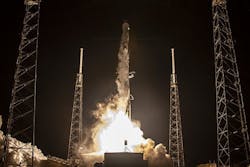That Starlink problem astronomers were worried about is totally happening
HAWTHORNE, Calif., - For the modern astronomer, satellites are just a part of life. There are more than 2,000 active ones currently orbiting Earth, and the smartest minds in space photography have managed to work out clever ways of removing the occasional fly over from their images of space. But then there's Starlink, writes Jacinta Bowler for ScienceAlert.com. Continue reading original article
The Intelligent Aerospace take:
November 20, 2019-When SpaceX announced its plan to launch thousands of objects as a "train" of satellites to bring high-speed internet around the globe, astronomers voiced their concerns. While not visible to the naked eye, the Starlink satellites show up as streaks on astronomers' cameras. With around 5,000 satellites currently in orbit around Earth - with more than 2,000 in use, SpaceX's plans dwarf what's currently in space. The California-based company wants to put up to 42,000 Starlink satellites into orbit.
With the second Starlink launch completed, worries raised by astronomers are coming to fruition.
"Wow!! I am in shock!!," exclaimed Cerro Tololo Inter-American Observatory astronomer Clarae Martínez-Vázquez in a Tweet. "The huge amount of Starlink satellites crossed our skies tonight at @cerrotololo. Our DECam exposure was heavily affected by 19 of them! The train of Starlink satellites lasted for over 5 minutes!! Rather depressing… This is not cool!"
Swinburne University astronomer Alan Duffy told ScienceAlert earlier this year that RF interference from Starlink satellites may be the death knell for terrestrial radio telescope exploration.
"A full constellation of Starlink satellites will likely mean the end of Earth-based microwave-radio telescopes able to scan the heavens for faint radio objects," Duffy said to ScienceAlert in May. "The enormous benefits of global internet coverage will outweigh the cost to astronomers, but the loss of the radio sky is a cost to humanity as we lose our collective birthright to see the afterglow of the Big Bang or the glow of forming stars from Earth."
Related: Destination space – Where will we be in 2020?
Related: SpaceX delivers final 10 Iridium NEXT satellites to low earth orbit
Related: NASA agrees to work with SpaceX on orbital refueling technology
Jamie Whitney, Associate Editor
Intelligent Aerospace
